Ravenloft: Realm of Terror
|
|
This section contains canon info from officially published sources |
This page refers to the original "Black Box" Campaign Setting. It is the only version of the campaign setting that predates the Grand Conjunction.
Product Information
- Authors: Bruce Nesmith with Andria Hayday
- Type: Campaign Setting
- Format: Setting Guide
- Release date: 1990
- TSR#: 1053
Contents
- A 144 page book, with the setting rules (including horror atmosphere creation hints), important NPCs and domains.
- 4 color maps - the Core, island domains, and towns, plus a clear plastic hex overlay tool
- 24 color cardstock sheets - various locales (ex: the Old Kartakan Inn), family portraits, etc.
- 1 transparent map overlay for measuring distance in the realm of doom.










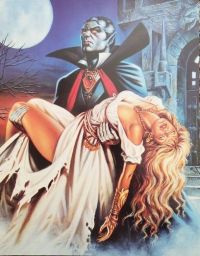


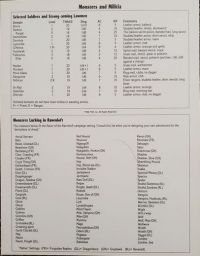


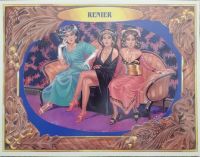






















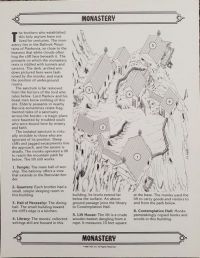




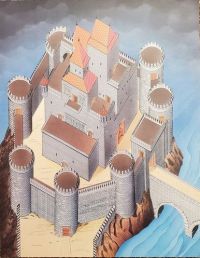











Notes
Mangrum observes that the "Realm of Terror started Ravenloft’s long-standing tradition of incoherence, a problem it’s still straining to escape today. To put it bluntly, Ravenloft just can’t keep it’s dates straight. The Bloodlines section highlights this problem- at first glance, these family trees are a wonderful tool for fleshing out your NPCs. But on a closer look, they contradict themselves, and they contradict information presented elsewhere in the book. Who’s Doomed tells us that Jacqueline Renier was a small child when her family entered Ravenloft, but according to her family tree she was born seven years after the creation of Richemulot. Eowin, Sean, and Ester Timothy were born to Cain and Elizabeth Timothy in 660. No problem, right? No problem at all, except the line above tells us that Cain and Elizabeth both died in 579."[1]
Kargatane Review Page[1]
By the time the Realm of Terror set was released, I hadn’t played more than a few sessions of AD&D; in years. I’d moved on to sci-fi games, avoiding fantasy RPGs as a whole because, basically, it all seemed very shallow. To me, most fantasy RPGs felt like the same old cardboard characters hacking away at that particular world’s version of orcs, and it all felt like the world was being made up as you went along. Then I picked up this boxed set, mainly because I thought it was some sort of revamped version of the original Ravenloft module. Chock it up to mild interest and a lot of nostalgia.
Instead I got a campaign setting which, quite frankly, blew me away. I love Ravenloft for one reason above all others: the characters. This collection of villains leapt off the page and totally engrossed me. I’m also a very visually-oriented person, so illustrations tend to figure heavily into my initial take on a game. I loved Stephen Fabian’s gloomy, atmospheric illustrations. These two points converged in the portrait of Azalin in the Who’s Doomed chapter. That one portrait captured his age, his intelligence, and his sheer power. His hollow eyes burned right into me, and I’ve been hooked ever since. Not only did I become an avid collector of all things Ravenloft, it brought me back to fantasy gaming as a whole.
But enough about this ol’ Kargatane; let’s talk about the boxed set. Realm of Terror took the information provided by two modules, Ravenloft (the all-time best selling AD&D; module) and its sequel Ravenloft II: The House on Gryphon Hill and expanded them into a campaign setting.
What You Get:
The Realm of Terror 144-page book, providing an overview of the mechanics of the setting, important NPCs and locations, and a heavy focus on creating the gothic atmosphere.
4 full-color maps. These include a map of the Core, a map of all the island domains, and two maps showing various towns.
24 color cardstock sheets. The fronts of these cards offer diagrams of various points of interest (such as Castle Ravenloft or the Old Kartakan Inn), portraits of various noteworthy families, or paintings of various Ravenloft subjects. The backs of the cards provide all sorts of quick reference information.
Stu likes to start with the bad so he can end on a good note, but I like to start with the high points, so I can build up a little goodwill before I bare my fangs and start ripping.
The Good:
First off is the setting itself; a deliriously inventive hybrid of AD&D-style; fantasy and famous tales of gothic horror. The characters are great fun, either taken as examples of the 1000 different flavors of evil, or just as a game of "spot the source material." If you’re a fan of gothic horror, either the original novels or the Universal and Hammer movies, you’ll have fun finding those characters transformed into their fantasy counterparts here.
Fear and Horror checks are introduced here. The rules are simple and effective, and never get in the way of good storytelling.
Realm of Terror offers extensive, effective guidelines for creating the mood of gothic horror.
I found all the NPCs instantly engaging. As I’ve mentioned, Azalin’s had me in his thrall ever since I looked into his gaze.
Stephen Fabian’s art is spot on perfect.
The Bad:
While the maps of the Core and island domains are just fine, the maps of the various cities provide relatively little detail. If you’re lucky, a few places of interest are pointed out, but for the most part you just get the main roads and the city’s general shape. The same complaint goes for the building diagrams on some of the cardstocks -they’re good for showing the players, and the backs offers a few details, but for the most part the DM is on his own.
Realms of Terror does an excellent job of establishing Ravenloft’s atmosphere. Unfortunately, it seems that Ravenloft’s more mundane details were overlooked in the process. Not all Darklords are described, and many domains receive only a paragraph or two of description. Exacerbating the problem is that until Domains of Dread fleshed them out a bit more seven years later, some of these domains still hadn’t been detailed.
Unfortunately, much as I love this box and the setting, Realm of Terror started Ravenloft’s long-standing tradition of incoherence, a problem it’s still straining to escape today. To put it bluntly, Ravenloft just can’t keep it’s dates straight. The Bloodlines section highlights this problem- at first glance, these family trees are a wonderful tool for fleshing out your NPCs. But on a closer look, they contradict themselves, and they contradict information presented elsewhere in the book. Who’s Doomed tells us that Jacqueline Renier was a small child when her family entered Ravenloft, but according to her family tree she was born seven years after the creation of Richemulot. Eowin, Sean, and Ester Timothy were born to Cain and Elizabeth Timothy in 660. No problem, right? No problem at all, except the line above tells us that Cain and Elizabeth both died in 579.
You can’t really blame Realm of Terror for this, but it’s worth mentioning: right from the beginning, Ravenloft has "served two masters," to quote Steve Miller. It’s a mix of heroic fantasy and gothic horror, and sometimes the two genres just don’t mix well. Fans have been debating Ravenloft’s true nature ever since.
In Short:
Ravenloft started out as a diamond in the rough. What it sets out to do, it does very well indeed, but a few details got lost along the way. But I’m still helplessly hooked, all these years later.
Andrew Hackard
I won't go on at length, because it's nearly impossible to find this product now, and most of the information has been superceded by later products anyway. But this is where it all started.
I played a combined I6/I10 game for a few sessions before our group ran out of time in the semester, so when I saw the Ravenloft boxed set I got it at once. I have never been disappointed since. The new mechanics, the card sheets, the artwork (especially the artwork!) all contribute to make this a stellar setting.
Mark Graydon
Well, I just got this one, but since I already have the Red box set and Domains of Dread, I don't really know what to say except that it was a good start to the demiplane. I don't like the disclusion of certain domain lords when the domains themselves are detailed, but this is corrected later. I do like the inclusion of permanent portals to the demiplane, and I like the cards, maps, and good NPC's.
Roman Gheesling
I encountered the original boxed set at a point where I was considering giving up on the hobby of role-playing games altogther. At that time, RPGs lacked the sense of wonder, mystery, and danger that I remembered when I first encountered D&D; (the old red box). The RPG sessions I played in were unplanned, hackneyed, and thoroughly uninteresting hack fests judged by bad GMs.
My opinion changed once I picked up the original Ravenloft set for a paltry $7.50. Here the setting was mysterious *and* dangerous. The PCs in a Ravenloft game weren't uber-characters and really had to keep their wits about them if they didn't want to die (or worse.)
The writers of the setting were aware that 90% of a great Ravenloft game is *atmosphere;* Accordingly, much of the Ravenloft material spent a great deal of space informing new RL gamemasters about how to create and maintain that atmosphere of "gloom and creep" that makes Ravenloft so great. Also, the writers made liberal use of recommending classic horror films and literature to inspire GMs to new heights of horrific creativity -- Many.
After reading the descriptions of the villains and the histories of the domains, I was thoroughly engrossed. Everything was so detailed, I truly was able to suspend disbelief and immerse myself in this eerie other-world. And I wondered why I'd ever considered giving up D&D.; . . .
the madcap
It may be strange, but I do think that if you want to be a DM in ravenloft, you've to put your hands on this boxed set. alright, Domains of Dread makes a wonderful job in describing any domain, featuring any Domain lord, spicing up rules for power checks and madness and horror... but it lacks something. Something that you can find here.
Maybe it's the sense of decay, wonder and horror, making its way through the pages of its 144 book that makes Realm of Terror so beautiful. Fabian's art is a must for ravenloft: it's gloomy and melancholic, but not violent and dark. the same is true for the whole setting: the original demiplane it's a place of supernatural powers, unknown to most people, a place of pain and sorrow.
It may seem a paradox, but even the old darklords were more frightening: Domains of Dread has a kind of "scientifical" approach to them explaining their powers and their weaknesses and their aims and their backgrounds... and thus making them more "human" and less frightening. Their descriptions in the Realms of Terror boxed set, instead, are barer but stronger: you won't learn much about Drakov's background, but you'll feel his desperation and helplessness (and his rage as well); you won't imagine why Markov makes his mad experiments, but you'll feel his madness and his curiosity.
Probably you'll think I'm crazy (I know I haven't done any strong point to support my statement), but there's no doubt in my mind that the original boxed set is a must that should find a place in any ravenloft DM's bookshelf. Maybe it's too loose... but that's why it gives you the power to feel the unexplanable.
John Glock
There is only one surefire reason to buy this product if you can find it. (Luckily I was there when it all began.) Sure it's chock full of fun artwork and information, but buy because it's the only place you'll find the island of terror named Staunton Bluffs. It seems that the Kargat all but forgot this tiny place. They don't mention it's disappearance in the Campaign Set or Domains of Dread. The inside on the Campaign set under this review section also dismisses it's very existance. The only place I've ever seen it referred to is in a NPC entry by John Mangrum (Thank you John) in the Book of Souls or Forgotten Children. (Irony of ironies, I've forgotten which.) Since no one will claim that it's disappeared, I say it's still out there. It may seem rather plain and uninteresting on paper, but it's horrors have yet to be fully explored. I was sad to see it so mistreated. *sniffle* (Another thanks to John for giving it some depth.)
Stu's Note: Actually, Staunton Bluffs appears in Islands of Terror, where it is thoroughly detailed. Steve Miller has noted that its exclusion from Domains of Dread was largely because of its similarity to Mordent. Oh, and John's article relating to Staunton Bluffs was in the Book of Souls...
Raven Dweller
Although it is very out of date I have just recently started to read through this box set. As with the other comments have stated Domains of Dread are far more deatailed and up to date. The one thing though that I have enjoyed is the old entries on some of the NPCs that are mostly featured in Champions of the Mist. These NPCs aren't updated like in Champions of the Mist but they show there origens and you can also find the statistics for the werewolf that George Weathermay is stalking! This is one of the main uses for theis product to me as a DM. And unfortenly to say this box set still has the best map for the einter Ravenloft Campaign. Other wise this product has long out lived its usefulness.
Mad StepDad
This one did it for me. The black box is absolutely essential to any who dare venture into the darkness that is Ravenloft. It completely sets the mood and tone of Ravenloft like absolutely no other product. Every time I rummage through the box, no matter where I may be, I always get the feeling that I'm in home in my bed on a rainy day, reading a good book. It still gives me a good chill, with it's black and white artwork, eerie writing style, and overall gloomy gothic appearence. Though descriptions and concepts are rather skeletal in this set (other items flesh out the setting much better), the black box none the less lets the DM know what Ravenloft is really all about, how it's supposed to be run, and how to truly maintain the believable illusion of real horror. The Black Box is an absolute must. Five blood drops.
Jeff Auer
I bought this when it first came out having loved the early eighties original Ravenloft module. It's hard to remember because the game has come such a long way, but at the time this was it! There was nothing else like it. It really set the pace. Between the newly redone Dark Shadows on network tv and this, I was in heaven.
Daniel Frohman
This set is very useful for setting up a background for many campaigns. It woudl have been a little better if it included a more detailed map of some of the very important places such as the inside of strahd's castle, but otherwise the pictures and maps it includes are helpful. The format of information presented for each domain is simple to reference. The overall organization is pretty good. I am pleased with this product, but I reccomend getting the Domains of Dread to update this product if you can.
CHRIS WOODS
Spring break, 1990. Panama City Beach Florida. I went to spring break for girls, booze, and parties. I never in a million years thought I'd find Ravenloft. When I saw the boxed set sitting on the shelf at the bookstore(don't ask me what the hell I was doing in a bookstore, I can't remember) I was stunned. I read the back of the box to try and figure out what the product was about. Was it a re-write of I-6/I-10? Was it something new based on the 1980's adventures? Or was it something totally unrelated? Since I had abandoned role playing for the past two years I didn't have a clue. The only money I had was beer money so I didn't by the boxed set, but I kept it in the back of my mind. A week later after I had recovered from my spring break exploits, I took a risk and bought the boxed set. I made the right choice. A true masterpiece, it drew me back in to role playing(and IMHO kept TSR in business). The set came with city and domain maps. The city maps i never used, but the domain maps are the best domain maps to date. Cards with portraits and estates were also included. I never used them either but the portraits were pretty cool. Now, to the book. Chapter 1 gives the inspiration from which the authors used to create the RAVENLOFT setting. Chapter 2 gives the history of RAVENLOFT. I was overjoyed to learn that the boxed set was indeed connected to I-6 and I-10. To learn of its history and its place among the TSR fantasy world was exciting. It set the rules of RAVENLOFT which made it different from all other fantasy worlds. Chapter 3 made it clear that players could no longer strong arm their way through adventures, and if they made the wrong decisions they could wind up becoming the very evil they were fighting. Chapter 4 introduced fear and horror checks. Spice for the game, nothing more. Chapter 5 focused on vampires and werebeast. I think this chaper could have been omitted for something else. After all, these creatures would get their own guide books later on. Chapter 6 was about curses. More spice for the game. Chapter 7 contained the gypsies. Personally, I think the gypsies are the most overrated and overused people in RAVENLOFT. They were supposed to add flavor to RAVENLOFT but wound up being so overexposed in the first years of RAVENLOFT that they lost their mystery and allure. Besides, they too would get their own book later on. Chapter 8 on telling the future was a total waste. Chapters 9 and 10, spells and items, again interestingly show the differences between RAVENLOFT and all other fantasy worlds. Chapters 11 and 12 is where RAVENLOFT really starts to shine. The domains. Words can not express the ingenius idea of the domains, its lords, its people, its climate, and its terrain. It was like the USA except each state was ruled by a cursed, evil darklord, who was a type for the greatest horror characters of TV, movies, and novels. Each state reflecting cultures and time periods from actual world history. A superb idea. The lands of the core, with the exception of a f)